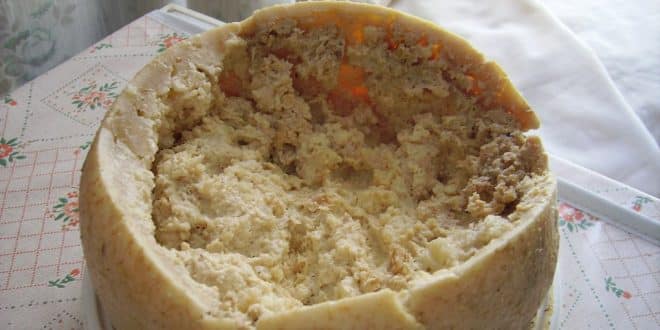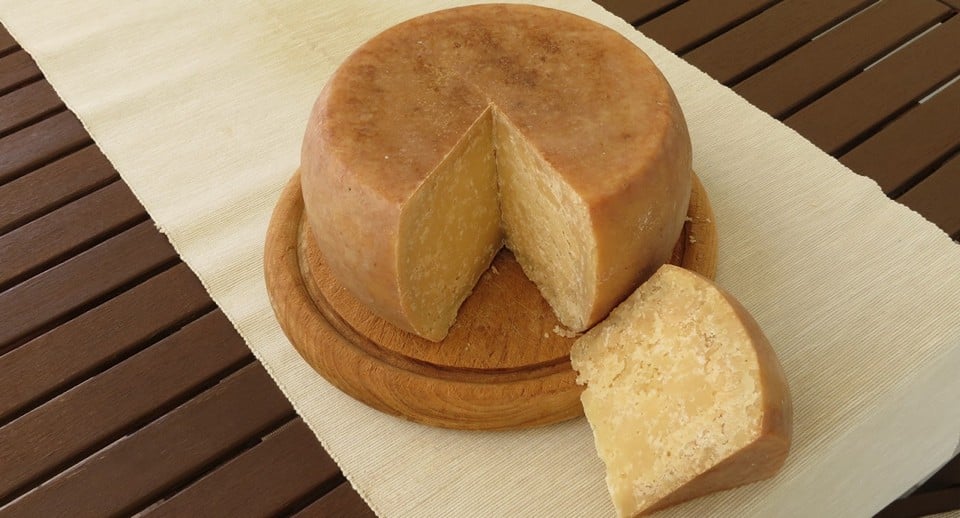“Tastes vary!” – as the English proverb goes. The Italian product we are about to discuss undoubtedly confirms this. And if you feel a slight discomfort from cheeses with mold, then Casu Marzu will surely make you dizzy. The homeland of this cheese is the island of Sardinia (Sardegna).
In literal translation, its name sounds like “rotten cheese.” It is filled with thousands of larvae of cheese flies. Surprisingly, it is eaten! Many Sardinians consider Casu Marzu an exquisite delicacy. If you are still up for it, let’s get acquainted with this “live” cheese.
Page Contents
Origin Story
The history of Casu Marzu is shrouded in mystery. There is no specific date or mention of the cheese in historical documents. However, the long-time residents of Sardinia, who preserve information passed down through generations, claim that this product has been around for centuries.
There is a version that Casu Marzu came into existence as a result of a mishap during the preparation of pecorino cheese. Not noticing the eggs of cheese flies, the cheese heads were sent for maturation, and after some time, they discovered the “rotten cheese.” Naturally, in times when food was scarce, throwing away a spoiled batch was not allowed by conscience or stomach. The bravest cheesemakers dared to taste it and were delighted by this new product made from sheep’s milk. That’s how the mass production of Casu Marzu began, so to speak.
It is also believed that the preparation of Pecorino in home conditions was always accompanied by the production of Casu Marzu, as during the summer period in rural areas, about 50% of the heads of cheese were consistently affected by cheese fly larvae. Therefore, with a significant degree of certainty, it can be said that “rotten cheese” has a thousand-year history.
Based on sanitary and hygiene regulations, the European Union has banned the production and sale of Casu Marzu. In order to protect the cheese, the Ministry of Agriculture and Forestry of Italy included it in the “list of traditional Italian food products” in 2004, which consists of 4006 items. This document allows manufacturers to deviate from sanitary standards since the product has been on the market for over 25 years.
In addition, in 2005, some Sardinian farmers, together with employees from the Veterinary Faculty of the University of Sassari, developed and implemented the breeding of cheese flies (Piophila casei) in an artificial environment. This enabled the producers to have complete control over the manufacturing process and ensure all sanitary and hygienic guarantees.
The latest attempt by Sardinian cheesemakers to establish their product was the submission of an application to the European Commission to grant Casu Marzu the DOP (Protected Designation of Origin) status. As of today, the European Union remains steadfast in its position.
Casu Marzu differs from other cheeses in Italy in that it has several variations of names: Casu Frazigu, Casu Becciu, Casu Fattittu, Hasu Muhidu, Formaggio Marcio.
In 2009, it was included in the Guinness World Records as the “most dangerous cheese in the world.” The authors describe the product as capable of causing vomiting, abdominal pain, and bloody diarrhea. However, there is no evidence of any gastrointestinal disorders associated with the consumption of Casu Marzu.
The Preparation Process
The first stage of Casu Marzu production involves the preparation of Pecorino Sardo, which falls under the DOP category. You can read about how sheep cheeses are made in our article “Pecorino – Italian Sheep Cheese.”
The heads used for obtaining Casu Marzu are immersed in a salt solution for fewer days than for Pecorino. During this time, the cheese absorbs enough salt to not repel flies but prevent the growth of pathogenic bacteria.
To attract the cheese flies, some producers create small holes in the cheese rind and drop a few drops of olive oil into them. This serves a dual purpose: to soften the surface and attract the flies. The future Casu Marzu is then left in open areas for the “attack” of Piophila Casei. During this time, the heads are not turned over. They are stacked on top of each other when enough eggs have been deposited on the cheese to ensure the transition of larvae from one form to another. The process of cheese fermentation by insects lasts from 3 to 6 months. Its completion is determined by the number of larvae and the texture, which is assessed by cutting off the top rind (cheese lid).
The production of Casu Marzu is mainly concentrated in the villages of Sardinia and takes place from late spring to late autumn. This period provides the most suitable temperature for the development of cheese fly larvae.
It’s worth noting that Casu Marzu is not the only cheese with larvae in Italy, but it is the most famous. Throughout the country, you can also find “Casu du quagghiu” in Calabria, “Furmai nis” in Emilia-Romagna, “Marcetto” in Abruzzo, and “Bross ch’a marcia” in Piemonte.
Characteristics and Consumption Methods
Externally, Casu Marzu heads are very similar to Pecorino. They have a cylindrical shape with convex sides and flat edges and weigh between 2 to 4 kg. Depending on the number of insects, the cheese’s consistency can be thick, paste-like, or soft and creamy. Aged variations have a very delicate texture with a liquid component called “lagrima,” which translates to “tear.” The mass is filled with semi-transparent larvae measuring about 8 mm in length.
Casu Marzu has a strong aroma reminiscent of mature Pecorino Sardo, but much more intense. The taste is spicy and pungent. The cheese leaves a long-lasting aftertaste that can linger for several hours.
Sardinians do not eat Casu Marzu if the larvae inside it have already died, considering such a product toxic. If the cheese is ready for consumption and still has a firm consistency, it is sliced and placed on Sardinian flatbread called pane carasau, usually accompanied by strong red wine. Soft Casu Marzu is spooned out and spread on bread.
Some people prefer to eat the cheese without paying attention to the larvae. The worms are quite active and can jump up to a distance of 15 cm. Therefore, Sardinians hold their hands above the sandwich to prevent the larvae from getting into their faces.
There are gourmets who choose to remove the insects. One method, invented by tourists, involves placing a portion of cheese in a paper bag and tightly sealing it, cutting off the oxygen supply. The larvae start jumping chaotically, drumming against the paper. When the tapping subsides, the bag is opened, and the dead worms are easily removed.
It is worth noting that the island’s inhabitants consider Casu Marzu an excellent delicacy and often serve it at festive tables during weddings and birthdays.
Caloric Content, Benefits, and Potential Risks
The exact nutritional value of casu marzu is unknown. Considering that the cheese is made from whole sheep’s milk, its caloric range can be estimated to be between 350 and 400 calories per 100 grams.
Like any cheese, casu marzu is a source of proteins (essential building blocks for the body) and calcium, which is necessary for the health of bones, teeth, muscles, and nerve impulse transmission.
In Sardinia, it is believed that “rotten cheese” is an excellent aphrodisiac, meaning it enhances sexual desire.
Information about the potential risks of consuming the cheese often includes:
- Allergic reactions
- Toxic poisoning
- Intestinal infections
- Stomach and intestinal wall damage
However, it should be noted that there is no documentary evidence supporting these claims. Everything is based solely on the assumptions of epidemiologists.
Price in Italy
You won’t be able to purchase casu marzu simply by visiting any grocery store in Italy. The sale of this cheese is prohibited, so you would need to search for it on the so-called “black market.” To indulge in its taste, you would have to venture into remote villages in Sardinia. Only there can your search be successful, and you can buy it at a price twice as high as that of pecorino cheese – 30-50 euros per kilogram. That’s what this “rotten delicacy” is all about!
Now you have enough information to decide for yourself whether it’s worth trying the “rotten cheese.” If you enjoy being surprised and surprising others, or if you have an adventurous gourmet spirit, then a trip to Italy is simply a must. Embrace new experiences, appreciate beauty, travel in true Italian style, and remember: “What doesn’t kill us makes us stronger!” So, why not head to Sardinia in search of eternal youth?
Interesting Facts about Casu Marzu
- Casu Marzu, an Italian cheese from Sardinia, holds the distinction of being one of the world’s most unique and controversial cheeses. It is known for its special ingredient: live maggots.
- The name “Casu Marzu” translates to “rotten cheese” in Sardinian. This cheese is made from pecorino, a sheep’s milk cheese, and undergoes a distinct fermentation process that involves the introduction of cheese fly larvae (maggots) into the cheese.
- The cheese fly larvae are intentionally introduced to the cheese to break down the fats, resulting in a soft and pungent texture. The maggots feed on the cheese, accelerating the fermentation process and creating a strong, tangy flavor.
- Casu Marzu is an acquired taste and a delicacy for adventurous food enthusiasts. The cheese has a strong aroma that some describe as “ammonia-like” due to the breakdown of proteins by the maggots. It is often enjoyed with caution and accompanied by local wines to balance its intense flavors.
- Consumption of Casu Marzu is not without risks. The larvae can still be alive when the cheese is consumed, and they are capable of leaping up to several inches in the air. Therefore, it is recommended to cover the cheese with a hand while eating to prevent any accidental encounters with the active larvae.
- Due to concerns over food safety, the production and sale of Casu Marzu are currently illegal in Italy and the European Union. However, there are still underground markets where enthusiasts can find this unique cheese.
- Casu Marzu holds a cultural significance in Sardinia and is considered a symbol of tradition and heritage. It has a long history in the region, with locals valuing it as a delicacy and a testament to their culinary heritage.
 Italy for me From Italy with love
Italy for me From Italy with love





